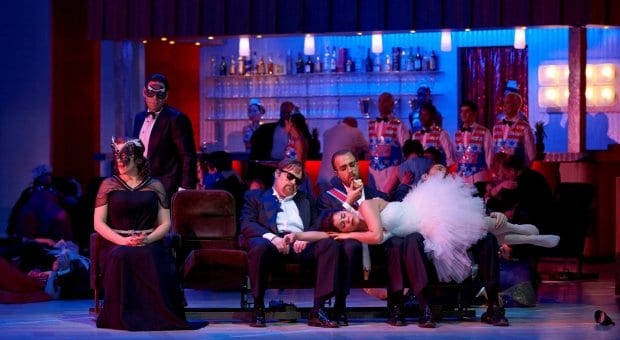Un ballo in maschera (A Masked Ball) by Giuseppe Verdi.
Libretto by Antonio Somma, based on Eugène Scribe’s libretto Gustav III.
Premiered in 1859. A 2008 Berlin State Opera production by Jossi Wieler & Sergio Morabito at the Canadian Opera Company 2014. Revival director Samantha Seymour, conductor Stephen Lord.
What happens? A powerful man is in love with a woman who happens to be married to one of his most loyal friends. The parallel plot involves the conspirators bent on assassinating the protagonist. The two plots braid in some unexpected ways involving a fortune teller, a veil, a meeting at midnight, the titular masked ball and a peculiar trouser role that seems a hybrid of Nicklausse and a Fate of Greek mythology.
Originally conceived as an opera about the historical assassination of Swedish King Gustavus III but promptly blocked by Neapolitan censors displeased by the idea of regicide onstage, the work changed locations and eras so many times that the musicologists stopped counting. The most often performed today is the version we are seeing at the COC, set in Boston when it was still a British outpost, with a count governor as the lead.
Why should you go? The music is one Verdian magic thing after another. Although you could, if that is how you listen, dismantle the opera into stand-alone set pieces, there is also in Un ballo a feeling of a composed-through flow because its many diverse elements hold together almost seamlessly. The solo aria may be preceded by a chorus extravaganza and followed by a trio, which may turn into a quintet, after which the chorus may return for a bit, and then Verdi will mix up several elements at once, and you will be in awe at how all this adheres so well. As if that weren’t enough, Verdi decided to throw together the style of some of the French opera of the time with the Italian opera: there aren’t characters like Oscar in Italian opera of the era, there is no singing in couplets, the grotesque and the ironic in style usually do not appear (whereas there are good examples of each of these in Offenbach’s The Tales of Hoffmann, for example). Ballo daringly mixes comedy and tragedy, with swift changes of mood and atmosphere. A composer at his most masterful.
How much is the lead soprano tortured? Surprisingly, Amelia survives and the tenor protagonist Riccardo is the one we bid farewell to at the end. Let’s give it only one out of four whips, as the soprano isn’t put through the wringer of the brutal societal disapproval, either: there is too much plot happening for the opera to be concentrating on punishing the unfaithful wife. And besides, there’s the big party everybody has to attend in the final scene.
What to look for in the music. Where to begin! How about the quintet (yes, you read that properly: five people singing different things at the same time) at the fortune-teller’s: in “È scherzo od è follia,” Riccardo is laughing at Ulrica’s prediction that he would soon die, while the two conspirators have their own sinister musical material and Oscar sings high and melodiously above everybody else. If you enjoy the soprano-tenor courting duets that take the time, the late-night meeting between Amelia and Riccardo, which has something like three and a half movements, will be just the thing. This scene ends with an absolutely delicious dramatic-comic melange, “Ve’ se di notte qui colla sposa,” involving the conspirators, the chorus and Amelia and her husband Renato. The chorus mocks the husbands, who find their displaced wives at most unexpected places at odd hours, and this jollity is periodically pierced by the painful marital breakup duet. Still later, in a moment of unequivocal solemnity, Amelia will sing the “Morrò, ma prima in grazia” solo aria. The final scene of the opera, true to the form, honours the promiscuity of the tragic with the comic, with a murder taking place while the dance orchestra keeps playing.
Conversation starter at the interval. “Let’s see . . . what other works of art can we think of that mix the funny and the sad particularly well? Novels, paintings, films?”
Un ballo in maschera (A Masked Ball) runs Sun, Feb 2–Sat, Feb 22
Four Seasons Centre, 145 Queen St W
coc.ca

 Why you can trust Xtra
Why you can trust Xtra


